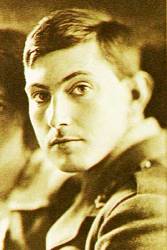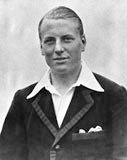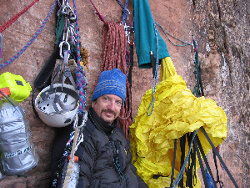
Left: George Mallory and Andrew Irvine © RGS/The Sandy Irvine Trust, from "Ghosts of Everest" ; Right: 1924 North Face locations © Pete Poston
| Photoanalysis | Routes & Maps | Video & Books | Contact Me |


"I'm quite doubtful if I shall be fit enough. But again I wonder if the monsoon will give us a chance. I don't want to get caught, but our three-day scheme from the Chang La will give the monsoon a good chance. We shall be going up again the day after tomorrow. Six days to the top from this camp!"
--from George Mallory's last letter to his wife prior to disappearing on Mt. Everest with his partner Andrew "Sandy" Irvine in 1924
"My face is in perfect agony. Have prepared two oxygen apparatus for our start tomorrow morning".
- Sandy Irvine's last diary entry

Does Mallory's watch point to the time of his death?
© Wim Kohsiek, Oct. 7, 2012
I became interested in the 1924 Mallory and Irvine climb on Mount Everest when I accidentally met Jochen Hemmleb on the way to Fairy Meadows at the base of Nanga Parbat in 2004. I read his book "Ghosts of Everest" and was impressed and amazed by what had been discovered in 1999. After that, my interest faded a bit till I read Wade Davis' book "Into the Silence".
I then wondered about Mallory's watch. In "Ghost of Everest" it was concluded that the watch did not give any clue as to what happened on the climb. Was this indeed so? A quick search on internet brought me to Jochen Hemmleb's recent article: ''What happened to Mallory and Irvine-A Synopsis",in which he proposes that Mallory's watch was damaged and stopped while climbing the second step, and to Pete Poston's article "Mallory's watch - does it really point to 12:50 pm?" (March 26, 2012),
In this article doubt is shed on Hemmleb's analysis, mainly because the stub that remained of the hour hand does not point to 12:50 but rather to 12:15, and the watch does not show severe damage: only the glass and the hour and minute hand are missing, but there are no scratches on the bezel of the watch, nor is the dial face damaged. Note that 12:50 is the time that Noel Odell saw the climbers somewhere on the NE ridge before they vanished in the clouds and were never seen again.
Let me summarize the facts:
Mallory wore the watch on his left wrist, upside down. When the watch was found in his pocket, the minute hand was missing, the hour and second hands were present. Pollard's photo, taken shortly after its recovery, shows the watch's hour hand pointing to about 1:30. For photo's, see Poston's article. During subsequent transport, the hour hand was dislodged and lost. The second hand appears to have moved several seconds between the instant of recovery, Hemmleb's photo in "Ghosts of Everest" and an analysis one year later. Another photo of the watch taken some (unknown) time after recovery shows only the stubs of the hour and minute hand. According to Poston's analysis the hour hand points to 12:15, and the minute hand to about 10 minutes before the hour. Obviously, this makes no sense.
Later it was found that the spring of the watch was not totally unwound, and the interior mechanism was in surprisingly good condition. Actually, the watch started ticking again after the rusted stubs were removed.
A watch expert, David Boettcher, consulted by Poston, declared that the glass (crystal) of the watch could easily be dislodged if hit at the "wrong" angle, He also commented on the state of the watch.
Now, my idea of what happened:
Before going to sleep on the night before the climb, Mallory wound his watch as usual. What precisely caused the damage to the watch the next day is a matter of speculation. One of the two scenarios that Poston mentions is that a bump from Mallory's ice axe dislodged the glass.
Following this suggestion, I can imagine that Mallory slipped while he had his ice axe in the left hand, the adze facing inwards, as is usual practice. The edge of the adze hit the watch, thereby dislodging the glass. Now, the hands were unprotected. Friction with the inner side of his gloves allowed the minute hand to pivot; finally it broke off.
The (smaller) hour hand did not slip, but was bent near its base.. I come to this scenario because of the way the hands are mounted: the hour hand is press-fitted on a hollow cylinder, and the minute hand on a notch atop of a pipe inside the cylinder. The minute hand can therefore much more easily slip rotate around its pivot than the hour hand (see the rough sketch from my watch smith at the end of this note).
So, the minute hand was forced from its proper position, which explains the nonsensical time of 10 minutes before quarter past twelve. The original position is unknown. The hour hand was bent by about one hour and 15 minutes forward in time.
The watch did not stop. Some time after the incident, Mallory checked for the time and uncovered his wrist. Then, the dislodged glass fell. Mallory saw the damage to the watch, but also noticed it was not ruined. He put it in his right pants pocket.
The watch kept running, save in Mallory's pocket. I will now present two scenario’s, A and B.
A.
Mallory’s watch stopped because it got too cold
On the fatal moment, Mallory slipped, fell and died. The watch, which was relatively protected from the cold by Mallory's body warmth, now cooled down.
An article by Moore et al., published in Weather, No. 8, 2010, pp.215-218, sheds some light on the temperature on the night of Mallory's death, the 8th/9th of June During the afternoon of the 8th, an atmospheric disturbance known as the Western Disturbance, hit the area with a dramatic drop in temperature and pressure, accompanied by strong winds. The disturbance lasted for some hours. At base camp, 5029 m, the temperature dropped to 4 oC, maybe even some degrees lower (the temperature was measured three times per day, but there is a gap in the data between 8 and 10 June).
Mallory's body was found at about the altitude of their camp VI. Let me assume an elevation difference of 3000 m. The actual lapse rate (temperature decrease with height) is unknown. According to the model atmosphere tables in "The physics of atmospheres" by J.T. Houghton (Cambridge University Press 1977) the lapse rate at 40 deg. N in June is about -0.7 oC per 100 m, giving a difference of -21 oC and a temperature of -17 oC. (Actually, Mount Everest is at 28 deg N, but the difference can be ignored here) This could be a conservative estimate, since it is known that during strong atmospheric disturbances the lapse rate is more close to the dry adiabatic, -1 oC per 100 m.
Not being kept warm any more, the wind cooled the watch quickly down to -17 oC (see my note on the cooling rate) which caused it to stop at 00:15 in the morning of the 9th, its spring having still some power left (I have a similar watch, its spring lasts 31 hours). The hour hand, bent, pointed at 1:30.
My conclusion A is thus:
Mallory died in the night of 8 June, between probably one hour, but not much more before midnight and midnight.
B.
Mallory’s watch stopped because the second hand got blocked.
The second hand is a tiny pin at the base of the watch and closely mounted to the plate, thus relatively difficult to get caught by clothing. It is also somewhat protected by the bezel, that sticks out from the plate. If this hand is blocked, the watch stops. Thus, inside Mallory’s pocket it may have been free. But Mallory’s fell, and his right leg was broken. The watch was in his right pants pocket. It could well be that the fabric of the pocket was pressed that much to the watch that the second hand was caught. In this respect it is interesting to note that the position of the hand was close to the upward position (60), as far as possible from the bezel.
The conclusion does not deviate much from the one above.


Note on the cooling rate:
Here, admittedly, there are considerable uncertainties. Where exactly was the watch, close to his body, or more to the outer layer(s) of his clothing? What would be the cooling rate of a body, lying on cold rocks, exposed to strong winds?
I will make an estimate of the heat loss of a body in two ways: (a) by means of the energy budget of a climber’s body, (b) by the heat loss through insulating material.(a) In intensive sports, a body may require 700 kcal/hour, equivalent to 816 W. (http://www.nutristrategy.com). The major part of this is dissipated as heat loss through conduction to the environment and evaporation through the skin and by breathing, the rest is available for mechanical work.
Note that the power to lift a body of 80 kg 300 m per hour, much larger than the climbing rate at 8000 m, is 65 W, thus the efficiency of the human body is low. (Actually, the efficiency of the human body at 8000 m is unknown to me, I found figures of 5.5% based on thermodynamical considerations and 25% based on O2 intake at 20 deg.C, presumably under sea level conditions, see http://secondlawoflife.wordpress.com/tag/energy-efficiency-human-body/).Suppose the body loses 0.2 litre water per hour through evaporation (thus 4.8 litre per 24 hours). This gives a loss of 117 kcal/h. Add to this 15 kcal/h for the increase of potential energy climbing at 80 m/h and 10 kcal/h for breathing in cold air and out warm air at 30 litre/min, 556 kcal/h is dissipated as so-called sensible heat transfer from the skin to the air. Radiation transfer is negligible at night. This is also valid directly after death. The heat capacity of a body of 80 kg is 80 kcal/ oC supposing it be water. Dividing the two gives an initial cooling rate of 7 oC /h.
Note that this estimate is critically dependent on two assumptions: (i) the calories burned in the body, here 700 kcal/h, and (ii) the water loss through evaporation, here 0.2 litre/h or 117 kcal/h. Other factors are far less important.
(b) the heat loss of a cylinder.
The following calculation is based on tables and text in “Principles of Environmental Physics” by J.L. Monteith, 1973, Edward Arnold (Publishers).
I idealize the body as a cylinder , length 1.8 m, diameter 0.24 m, filled with water. This has a mass of 80 kg and a surface of 1.36 m2.
The cylinder is covered with insulating material. In calculating the heat flow, an electric analogue is used, where the flow is expressed as the temperature difference divided by the thermal resistance. Here, there are two resistances in series, the insulation and the resistance to the air.
The latter is calculated with an empirical formalism. At a wind speed of 10 m/s, and an air pressure of 370 mbar, it is 25 s/m. The dependence on the air speed (u) is u**-0.81.
Now, at a temperature difference of 37 minus –17 oC = 54 oC, the initial cooling rate is
3.9/rm (oC/h), where rm is the insulation resistance in s/cm. The rm of a 1 cm thick layer of wool lies between 1.5 s/cm and 2.8 s/cm, giving cooling rates of 2.5 and 1.4 oC/h, respectively.
In both estimates I have assumed that the body cools as a whole, but undoubtedly a gradient will develop, the outside will cool more rapidly than the core. In the second estimate the surface/volume ratio is smaller than that of a real body, which works to underestimate the cooling rate. Also, the watch was close to Mallory’s leg, which has a larger surface/volume ratio than the body as a whole.
Considering these estimates, I think that the initial cooling rate of the outer body parts is larger than quoted cooling rates, like 1.5 oC/h, that refer to the inner body parts at less extreme external temperatures.

Articles and Editorials
![]() Harvey V. Lankford, MD, has written a paper documenting the origin of the term "Glacier Lassitude" as a diagnosis for the debilitating effect of altitude as experienced by members of the early British Everest expeditions.
Harvey V. Lankford, MD, has written a paper documenting the origin of the term "Glacier Lassitude" as a diagnosis for the debilitating effect of altitude as experienced by members of the early British Everest expeditions.
![]() My new theory about Mallory and Irvine's last climb, where I believe Odell's sighting was erroneous, and have them taking the Couloir route instead.
My new theory about Mallory and Irvine's last climb, where I believe Odell's sighting was erroneous, and have them taking the Couloir route instead.
Part 1: the ascent
Part 2: the descent
![]() Warwick Pryce is a new researcher who has arrived on the scene, and he has a new theory about how Andrew Irvine could have been the first person to stand on the top of the world.
Warwick Pryce is a new researcher who has arrived on the scene, and he has a new theory about how Andrew Irvine could have been the first person to stand on the top of the world.
Wim Kohsiek has a new interpretation of what Mallory's altimeter can tell us based on scientific applications of meterology.
Mallory and Irvine researcher Wim Kohsiek has two new thought-provoking articles about Mallory's watch and Irvine's location:
Mallory's Watch - Does it Really Point to 12:50 PM?
1924 Oxygen by Richard McQuet and Pete Poston
Why the Camera and Film are not Doomed to Destruction!
The Politics of Mallory and Irvine
Why Andrew Irvine Will Not be Found in a Sleeping Bag! Part 1 and Part 2 on ExplorersWeb
Chomolungma Nirvana: The Routes of Mount Everest
Rust Marks on Mallory's Altimeter
Mystery of Mallory and Irvine's Fate Google Earth Tour - my own ideas in 3-D with audio!
Little Known Free-Solo Ascent of the Second Step in 2001 by Theo Fritsche - I should never have written this - Anker and Houlding deserve credit for the first free ascent
Criticisms of the 2004 EverestNews.com search for Irvine --
The Mystery of Mallory and Irvine's Fate (with J. Hemmleb): Part 1, Part 2, Part 3, Part 4, Part 5.
Mallory and Irvine - Comments on the 'real Second Step' route: Part 1 and Part 2
Conrad Anker's comments on the unlikeliness of a direct route up the prow of the 2nd Step
Articles about my heroes Walter Bonatti and Chris Bonington --
Spilling the Beans - Lino Lacedelli's Book "Price of Conquest: Confessions from the First Ascent of K2" Part 1 and Part 2
The Life and Climbs of Chris Bonington, Part 1, Part 2, Part 3, Part 4, Part 5 final - interview
About Me
 Celebrating my 50th birthday on pitch 3 of Prodigal Son, Zion National Park, Utah
Celebrating my 50th birthday on pitch 3 of Prodigal Son, Zion National Park, Utah
In my free time, I love to photograph and hike the spectacular redrock wilderness of the Colorado Plateau - please visit my Colorado Plateau Homepage.
And for most of my life I've been fascinated with the history, people, and culture of the Himalayas and Karakoram - browse my Mount Everest Trek (1996), Overland Journey from Kathmandu to Lhasa (2000), and K2 Base Camp Trek (2007) webpages.
As for my employment, I work for Western Oregon University where I have been a Professor of Chemistry for the last 20 years. My research interests are in applications of Laser Raman Spectroscopy to such diverse fields as Nanotechnology, Analytical Chemistry, and even a bit of Achaeology through the study of rock art pigments found in the Colorado Plateau. You can access my academic webpage here.

Copyright (c) 2004-2022 Pete Poston. All rights reserved. Visitor's Agreement |